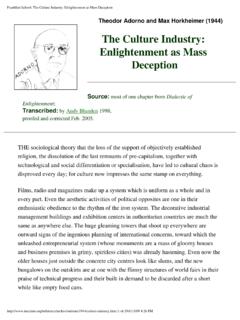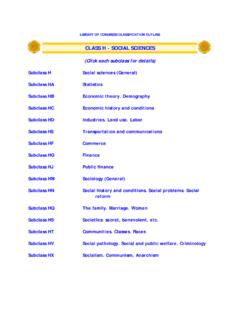Transcription of Media in the 1960s & 1970s - J387: Media History
1 Media in the 1960s & 1970sThe 1960s : Media : OverviewNot a RevolutionIn the Media , if not in other segments of American life, the 1960s were a decade of consolidation, not revolu-tion. After the radical change brought about by televi-sion in the 1950s, the next decade was consumed with evolutionary change as television and radio broadcast-ers, newspaper and magazine publishers, and the gen-eral public attempted to come to terms with the revolu-tion they had made in the previous ProblemsThe television industry saw two new technological wrinkles come into widespread use, but neither was a new idea. By the end of the decade the majority of programs were broadcast in color, even if in 1967 only 15 percent of American homes were equipped with color television. UHF-band broadcasting was also given the regulatory go-ahead, though it was still looked down upon as a poor substitute for VHF , or the Lack ThereofWhatever the technical format of the broadcasting, the content of the programs being shown became a center of controversy during the decade.
2 Federal Communica-tions Commission (FCC) chairman Newton Minow came into office in 1961 with a strong condemnation of the poor quality of most television programs. Net-work officials responded that they only gave the audi-ence what it wanted. And it apparently did not want the level of cultural broadcasting that Minow and other critics TelevisionOne solution, if not the one Minow advocated, was the formation of the Corporation for Public Broadcasting (CPB) and the Public Broadcasting System (PBS) in 1967. Up and running by 1969, PBS and the programs funded by the CPB gave viewers alternatives to net-work broadcasting that were not otherwise available until the rise of cable in the 1980s. Children s televi-sion was one of the prime concerns of the CPB, one of its first programs being Sesame Street. The woeful level of children s programming on the networks was a topic late in the decade, but not until the 1970s was it seriously IssuesWith the social turmoil of the 1960s the assassina-tions, the civil rights movement, the anti-Vietnam War protests, the youth culture television was compelled to address the issues facing the American public.
3 Black A magazine ad for an RCA color TV featuring the NBC pea-cock logo developed especially for its full-color program chairman, Newton Mino, who called television a vast wasteland. Americans gained a more prominent position on televi-sion during the decade, as did young people. Most crit-ics pointed out that television did a poor job in its at-tempts at investigating and explaining social problems but that the society at large did not do a good job ei-ther. Nonetheless, the goal of bringing more segments of the American public into the world of television was a new and laudable one, however imperfectly of Television NewsThe 1960s were the decade of television news. Begin-ning with President John F. Kennedy, presidential press conferences began to be held according to the needs of television, a change that did not enthrall the print jour-nalists.
4 But even they had to recognize the superiority of television s coverage of the 1963 assassination of Kennedy. The five days of almost-continuous coverage given by the networks to the events surrounding Ken-nedy s death, the killing of Lee Harvey Oswald, and the Kennedy funeral had a drama and immediacy that other Media could not come close to big news events throughout the decade the Vietnam War, the Apollo moon landings played to the strengths of television and reduced the relative stature that other Media had historically enjoyed. Radio, which had for decades been the medium of immediacy, found itself becoming what Newton Minow called publicly franchised jukeboxes. Helped by the development of the transistor and the truly portable radio set, most ra-dio programmers adapted well to the medium s changed role of providing musical entertainment to young people and automobile Plight of NewspapersNewspapers, however, were still struggling both with their mission in a world with television and the eco-nomics of their changing business.
5 Faced with an audi-ence which now had many more choices for news and entertainment, newspapers also were hit with rising production costs, stubborn unions, and a changing newspaper market. Newspapers found that they were outclassed by television as immediate news outlets and Bill Cosby in one of his first TV roles as a tennis-playing international spy. I Spy also stared Robert Culp as his partner and was the first drama to feature an African-American in a lead Cronkite announcing the death of President Ken-nedy, live on CBS. The breaking story interrrupted CBS s usual soap opera disc-jockey Wolfman Jack, whose gravelly voiced delivery made him a favorate for over two radio and television as entertainment and as adver-tising outlets. During the decade most newspaper mar-kets underwent severe rationalization; in New York the number of major daily newspapers shrank from seven in 1959 to three in 1967.
6 Total newspaper circulation in the city was reduced during the same period from million to million. Total circulation for all newspa-pers in the United States rose slightly to million by 1971 but remained stagnant thereafter. Small-town newspapers were responsible for much of this growth, so larger newspapers were left with a smaller slice of the circulation faced many of the same troubles as news-papers. By the 1950s and 1960s general-interest maga-zines were no longer thought of as a major source of entertainment for the general public, despite the fact that circulations had remained steady. As a result, ad-vertising became harder to attract in competition with television and radio. Magazines were also troubled with rising costs at a time when revenues were stag-nant. One of the best-known American magazines, the Saturday Evening Post, disappeared in 1969, a victim not of a lack of quality but of the public s and advertis-ers lack of interest.
7 The great age of the general-interest magazine was over; successful publications were either those which serviced niche markets such as Penthouse, the English soft pornography magazi-ne or those, like the news-magazines, which served more utilitarian purposes. The major newsmagazi-nes Time and Newsweek continued to flourish, both part of Media empires: Time, part of Henry Luce s Time-Life; and Newsweek, since 1961 part of Kather-ine and Philip Graham s Washington Post World to ComeChange is constant, though the nature of that change is variable. Just as the revolutionary change of the 1950s had its origins in developments in the 1920s, 1930s, and 1940s, events in the 1960s would not have their full impact until the 1970s , 1980s, and 1990s. The launch of the Telstar and Early Bird satellites affected the Media in the 1960s , but it would be the 1970s and 1980s before opportunities for global broadcasting would be more fully realized.
8 The regulatory mess with UHF broadcasting would affect the development of cable television in the 1980s. The ultimate effects of Media changes in the 1960s have yet to be felt fully. The 1960s : Media : Overview. American Decades. 2001. (August 30, 2013). last cover of the the Saturday Evening Post, February 8, 1969 The Worst of Times, the Best of TimesAfter the social and cultural upheavals of the 1960s , the 1970s in general seemed a less exciting decade. in the Media , however, things were definitely exciting, par-ticularly as the concerns of the preceding decade af-fected everyday practice in newspapers, magazines, radio, and television. The Media helped to uncover military abuses during the Vietnam War and exposed a corrupt presidential administration; magazines pro-moted social reforms with a vigor they had lacked for several years; and even television adopted a more so-cially responsible standpoint.
9 The United States as a whole may have seemed to linger in a cultural and po-litical malaise during the 1970s , but the Media were more active than of the political malaise of the decade, many social problems were addressed in the Media and enter-tainment rather than in more practical arenas. Much of the entertainment Media was simply commercial, but even popular situation comedies and television dramas addressed social issues. Norman Lear s situation comedies, particularly All in the Family, dealt with controversial issues television usually avoided, such as race relations, feminism, sexuality, and abortion. Like-wise, M*A*S*H mixed the humor of the sitcom with the horror of a war drama. A new wave of minority comedies, such as Stanford and Son, Good Times, Chico and the Man, and The Jeffersons, employed stereotypes occasionally in fact, actor John Amos left Good Times in 1976 over a dispute with producer Lear about how the character of J.
10 J. revived traditional cari-catures of blacks but such shows changed the nature of American television. On Saturday mornings kids could learn about the dangers of drugs and of strangers from a wide range of characters. Television was not alone in such matters: comic books violated their own content codes to promote antidrug messages, while new magazines such as Ms. and Mother Jones devoted themselves to progressive 1970s : Media : Overview(Above right) M*A*S*H was one of the most-watched shows on TV for 11 years. (Right) The cast of Good TImes, one of a number of sticoms during the 1970s featuring a pre-dominently African-American from Hard TimesWhile the Media entertained viewers, listeners, and readers, the serious issues kept piling up. The 1970s were depressing in many respects: Americans wit-nessed the fall of a president, defeat in Vietnam, reces-sions and energy crises, and fellow Americans held hostage.









